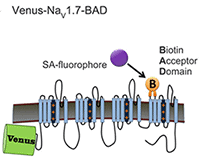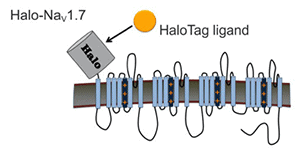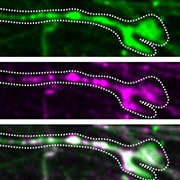The sodium channel Nav1.7 is a key regulator of the firing of nociceptive neurons, and mutations in this channel can result in pain conditions as well as insensitivity to pain. However, despite the well-recognized contribution of Nav1.7 to nociceptive signaling and human pain perception, the distribution of Nav1.7 channels along sensory nerves, and how they are delivered to their final destination, remains poorly understood.
A new study led by Stephen Waxman and Sulayman Dib-Hajj, both of Yale University, New Haven, US, and the Veterans Affairs Connecticut Healthcare System, West Haven, US, describes for the first time the distribution of Nav1.7 channels at the cell surface of dorsal root ganglion (DRG) neurons as well as their transport along axons. Using live-neuron imaging combined with a microfluidic culture system, the researchers show that these channels localize to “nanoclusters” on distal axons. The investigators were also able to visualize the anterograde transport of Nav1.7 in cell vesicles traveling from the cell soma down the axon.
Furthermore, the group demonstrates increased Nav1.7 channel trafficking to the cell membrane at the distal axon under inflammatory conditions, providing new insights into the role of these channels in inflammatory pain.
“This paper is very exciting, as there has been such a dearth of information on how sodium channels are trafficked in the axons of nociceptive neurons, and in particular the Nav1.7 channel with its role in pain mechanisms,” said Ted Cummins, Indiana University-Purdue University, Indianapolis, US. “It’s helpful to know how it gets to its site of action and where specifically it goes in the peripheral nervous system,” said Cummins, who studies the biology of sodium channels but was not involved in the current work.
The study, which was supported by the U.S. Department of Veteran Affairs Rehabilitation Research and Development Service, appeared online October 23, 2019, in Science Advances.
Let there be light … but not too much
The impetus for the new study, according to Dib-Hajj, was that previous research had provided only a limited, static view of where Nav1.7 channels are in sensory neurons and how they move about the cell.
“The Nav1.7 channel has been found in all of the neuronal compartments of primary afferents, from the nerve endings in target organs right up to the central terminals. However, the evidence to date for its expression and distribution has only provided a static picture and doesn’t give any sense of spatial and temporal regulation of the trafficking of these channels. We were interested in the dynamic movement of these channels, and so we designed new methodologies to address this,” Dib-Hajj told PRF.
To reach their goals, the researchers needed to single out and highlight individual Nav1.7 channels from the myriad of other intracellular components floating in the cytoplasm.
“Imagine that you have a crowd of people in a stadium at night, and you wanted to be able to follow just a few people. If everybody takes out their cell phone, then there would be light everywhere, but if instead you just give a few people a bright spotlight, then you can watch where they go,” explained Elizabeth Akin, first author of the study.
“This is the challenge in microscopy: Often there is too much signal, which means you can’t track just a few individual molecules,” Akin continued. “So we found a way to give really bright fluorescence to a few molecules and, by making everything else dark, we were able to visualize the Nav1.7 channels with high sensitivity,” Akin said.

To allow for dynamic live-cell imaging of Nav1.7, Akin and colleagues developed a fluorescently tagged Nav1.7 construct. This construct consisted of a yellow fluorescent protein called Venus that was attached to the N-terminal of Nav1.7, as well as to an extracellular tag called a biotin acceptor domain (BAD) to which a fluorescent compound can attach. They called the construct Venus-Nav1.7-BAD.

To visualize trafficking of the channel, the investigators developed another Nav1.7 construct containing HaloTag, which is a protein tag that binds strongly to synthetic ligands, in this case a fluorescent ligand. They placed HaloTag on the extracellular side of a 25-transmembrane channel protein that they created.
The third component of the researchers’ methodological approach was to culture the DRG neurons in microfluidic chambers. Here, somas (cell bodies) are plated into a chamber (somatic chamber), and the axons extend through tiny grooves into another chamber (axonal chamber). This allowed the researchers to follow the movement of Nav1.7 as it was being transported in vesicles (small enclosed sacs that contain cellular components) from the soma and along the axon.
![Schematic of the OPAL [optical pulse-chase axonal long-distance] imaging technique used to visualize anterograde vesicles containing NaV1.7. DRG neurons expressing Halo-NaV1.7 were cultured in MFCs [microfluidic chambers] for 7 to 10 days. Immediately prior to imaging, JF549-Halo [JF549 is a HaloTag ligand] was added to the somatic chamber for 15 min. After removal of excess dye, axons within the axonal chamber were imaged using spinning disk microscopy to visualize anterograde vesicles traveling from the somatic chamber into the axonal chamber. Caption and credit from Akin et al., Sci Adv. 2019 Oct; 5(10):eaax4755. Creative Commons Attribution-NonCommercial license.](https://www.iasp-pain.org/wp-content/uploads/2023/02/Nav1.7-ChannelsInline-3_Somatic-chamber.png)
Where are the channels …
Using the Venus-Nav1.7-BAD construct, the group first looked at the somatic chamber, and saw expression of the Venus signal in the soma of the DRG neurons and in neurites projecting from the soma. Use of a cell surface label revealed that the Nav1.7 channels were localized within the plasma membrane.
Then, looking at the axonal chamber, the team saw a beadlike pattern of Venus fluorescence throughout the axon, and particularly its distal terminal region. The signal pattern of the surface label indicated that the Nav1.7 channels accumulated in distinct puncta, which the researchers called nanoclusters, defined as small membrane regions containing multiple Nav1.7 channels. There was a median of 12.5 channels per nanocluster at the plasma membrane at the ends of the axons.
“We and others have proposed that Nav1.7 is a threshold channel, critical for the initiation of action potentials, so ideally you would expect it to be near the terminal ends of the axons,” explained Dib-Hajj. “This is why the channel organization we saw makes sense; however, we need to remember that these are immature neurons, and the culture system we used is a neuronally enriched one that lacks the complexity of Nav1.7 target organs such as the skin,” he said.
Along similar lines, Cummins said it’s unclear whether the findings from the culture system would apply to the in vivo situation.
“The in vitro system that the authors used contains neurites that may only be a centimeter in length, while in vivo, particularly in humans, axons can be up to a meter in length. We don’t really know as of yet how these results will translate to an in vivo system,” Cummins told PRF.
… and how do they get there?
The Venus-Nav1.7-BAD construct, although ideal for observing surface channels, is unsuited for visualizing anterograde vesicular trafficking of Nav1.7. To achieve this, Akin and colleagues added fluorescently labeled HaloTag ligand to DRG neurons cultured in the somatic chamber. Then, they used a type of microscope called a spinning disk confocal microscope to visualize the movement of Halo-Nav1.7-containing vesicles from the somatic chamber into the axonal chamber. With this approach, they could see trafficking of individual channels from the cell body to the distal axon.
The researchers discovered that channels labeled in the somatic chamber could indeed be selectively visualized in the axonal chamber. The majority of these channels continued to move along the axon to the distal end, providing ─ for the first time ─ direct visual evidence of Nav1.7 channel trafficking along axonal membranes.
“It’s very exciting to be able to visualize, in real time, single sodium channels in transit along sensory axons,” said Waxman. “These new results are important, as neurons are unique in being able to communicate via action potentials, and we are beginning to be able to see how neurons build their membranes where sodium channels produce action potentials.”
Ion channels are transported to the cell surface in vesicles, a process facilitated by microtubules (tiny hollow rods that are one of the main components of the cytoskeleton). To learn if the transport of Nav1.7-containing vesicles was dependent upon microtubules, cultured axons were treated with nocodazole, a microtubule-destabilizing agent. Nocodazole treatment reduced the velocity of Nav1.7 vesicular transport along axons as well as the number of forward-moving vesicles. This confirmed that Nav1.7 vesicular trafficking indeed relied on microtubules. Further, the protein Rab6A, a marker for vesicular trafficking, was co-transported along with Nav1.7 in approximately 70 percent of vesicles.
“Understanding the molecular machinery involved in Nav1.7 trafficking, and identifying specific proteins involved in the pathway, is very important, as we could potentially target them for novel pain treatments. If we can prevent additional sodium channels from getting to the end of the axon, then that could potentially be used as a therapy for pain,” said Akin.
Inflammatory changes
All of the above experiments were performed under normal conditions. But since Nav1.7 is upregulated in inflammatory pain, the researchers investigated how inflammatory conditions might alter Nav1.7 trafficking and distribution.
Patch-clamp electrophysiology experiments using cultured DRG neurons treated with a cocktail of inflammatory mediators for four hours confirmed a substantial increase of Nav1.7 electrical current in the cells.
Application of the inflammatory mediators also resulted in enhanced anterograde trafficking of Nav1.7 along the axon, with increases in the number of channels per vesicle, the number of Nav1.7-carrying vesicles per axon, and the speed with which the vesicles moved forward.
Finally, the team saw that, just as under normal conditions, Nav1.7 accumulated at the plasma membrane of distal axons under inflammatory circumstances, and that channel trafficking again depended upon microtubules.
![Compressed z-stacks [z-stacking is a digital imaging processing method] of distal axons under control conditions (left) and after exposure to IM (right). Under both conditions, nanoclusters can be seen along the distal axon with both the Venus signal (green) and CF640 surface labeling (magenta). Caption and credit from Akin et al., Sci Adv. 2019 Oct; 5(10):eaax4755. Creative Commons Attribution-NonCommercial license.](https://www.iasp-pain.org/wp-content/uploads/2023/02/Nav1.7-ChannelsInline-4.png)
Together, courtesy of the study’s novel experimental approach, the results showed how Nav1.7 channel distribution and trafficking are affected during conditions that mimic a disease state.
As for future work, Dib-Hajj believes the new imaging methods employed in the current work have vast potential.
“The power of the approach that we have described is that you can apply it to any membrane channel or protein, so you can begin to answer questions that have so far been unanswerable. To date, isoform-specific blockers of Nav1.7 sodium channels have not shown the expected efficacy in human clinical trials for treating pain. We are particularly interested in the trafficking components of this channel that could themselves be targets for drug development,” Dib-Hajj said.
Dara Bree is a freelance science writer based in Boston, US.


